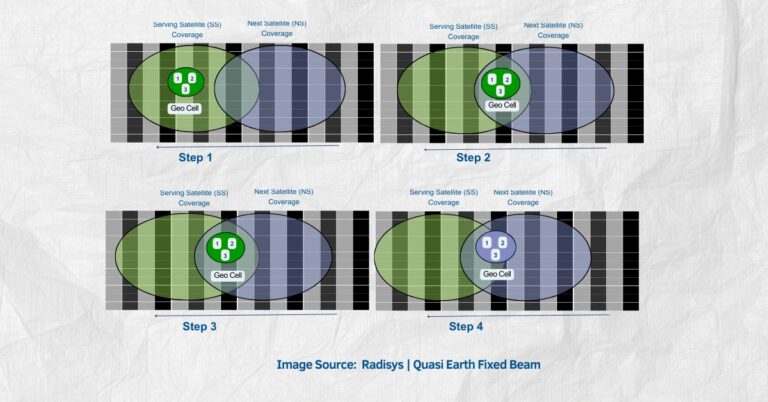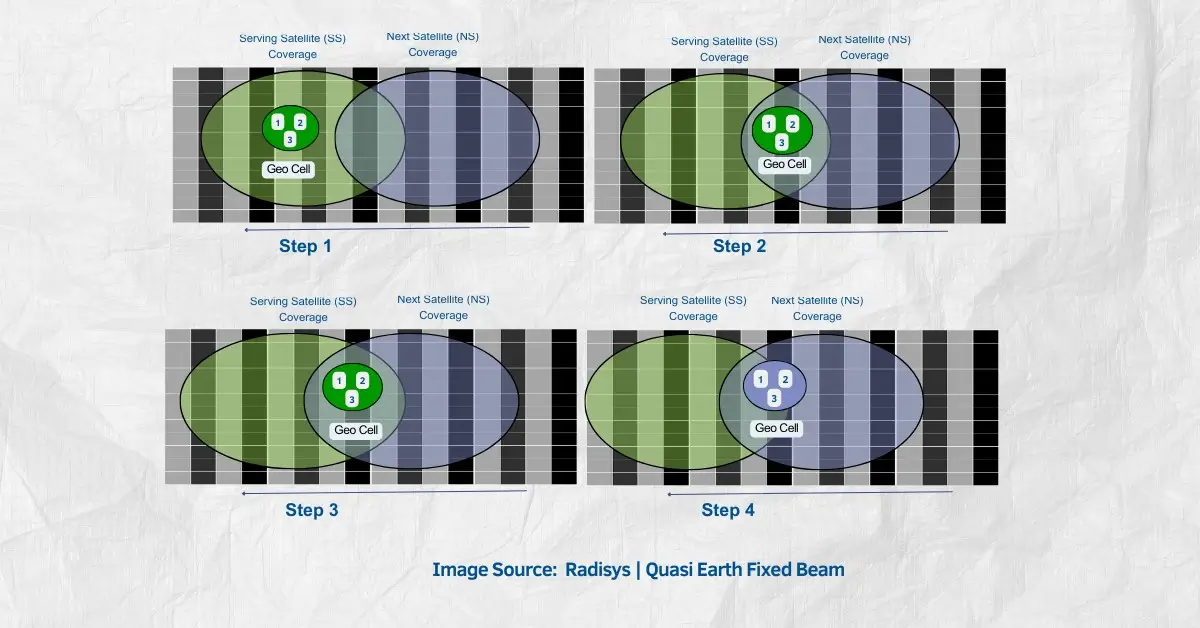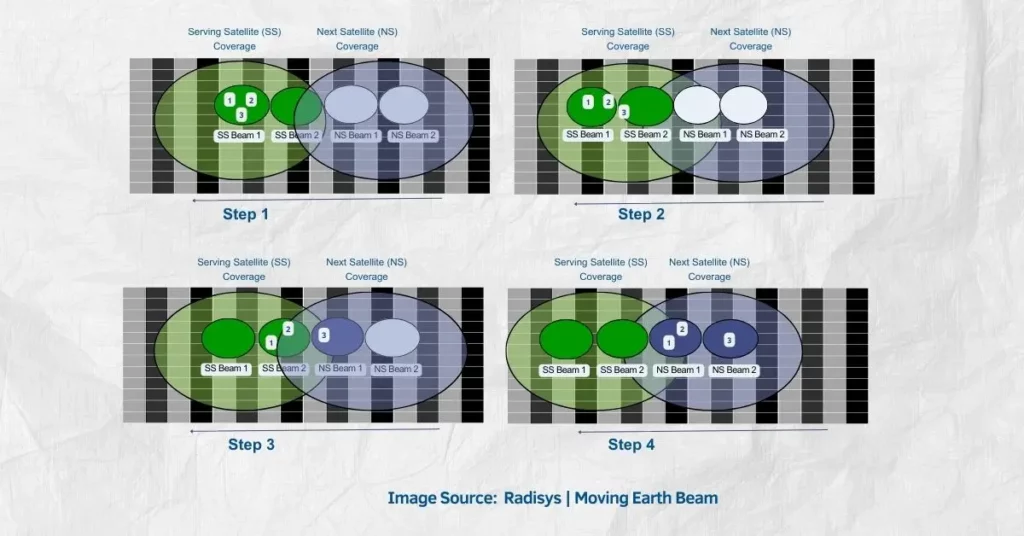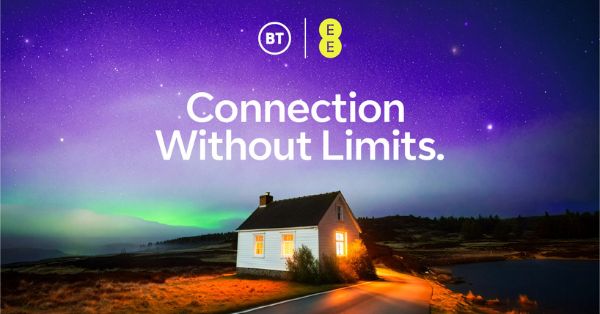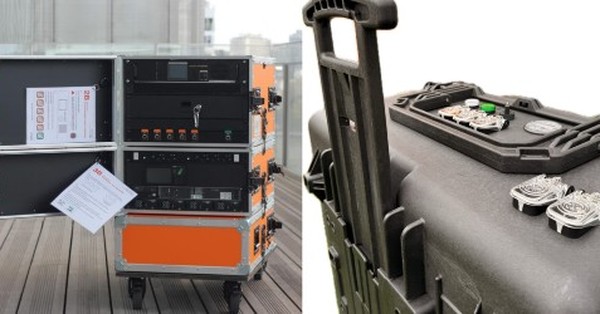In my previous blog, I explored regenerative non-terrestrial network (NTN) deployment architectures, including both partial and full regenerative systems. The blog discussed NCF considerations for regenerative NTN systems, SWaP and SW architecture considerations, and the challenges of deploying a regenerative NTN architecture.
Quasi-Earth fixed beams vs. Earth-moving beams Explained
For this blog, I would like to discuss Quasi-Earth fixed beams vs. Earth-moving beams, including their differences, impacts, and functionality for network architectures.
First, let’s discuss the 3 types of beams defined:
- Earth-fixed beams – these are satellite beams of a geostationary satellite that continue to cover the fixed and same area on the ground. The satellite antenna and the beams are non-steerable, but due to geostationary orbits, the illumination on the ground by the satellite beam(s) remains the same.
- Quasi-Earth fixed beam – typically deployed for Non-Geostationary Orbit (NGSO) on Low Earth Orbit (LEO) and Medium Earth Orbit (MEO) satellites with steerable antennae allowing the beam to be steered to cover a fixed geographical area on the ground for the duration of satellite visibility at the location, which typically is for a few minutes.
- Moving-Earth fixed beam – typically deployed for NGSO (MEO/LEO) orbit satellites with a non-steerable antenna causing the satellite the beam to sweep over the geographical area on the ground, as the satellite moves, causing the shifting geographical cells on the ground
First, I would like to discuss Quasi-Earth fixed beams and Moving-Earth fixed beams as well as their applications, functionality, and mobility.
Understanding Quasi-Earth Fixed Beams in LEO/MEO Networks
For satellites with steerable antenna capabilities, allowing the beam to be steered to a location on the ground as the satellite moves, enabling the satellite beam to provide coverage to a geographical location for the duration the satellite is over the horizon. This technology is applicable to both transparent and regenerative Systems.
Stationary UEs continue to be served in the same geographical cell through different Satellite beams. The association of a Geographical cell to a Satellite beam changes with time. For the duration of satellite coverage of a geographical cell, the satellite steers its beam to illuminate the same geographical cell. A new satellite beam can also be steered to ensure that it continues to serve the same geographical cell when the previous satellite beam stops serving due to the satellite’s motion.
The association of an on-ground / geographical cell to a satellite beam changes with time for a transparent system wherein the same gNB cell instance always serves a geographical cell. The DU cell instance always broadcasts the same set of TACs.
On the other hand, for a regenerative NTN system, each DU/gNB cell instance association with satellite stays fixed, and therefore the DU/gNB Cell to geographical cell association changes with time, as the satellite moves. The DU/gNB cell instance broadcasts a TAC list that changes with time and satellite motion.
Referring to the figure above:
- Step 1: The cell is fully under the coverage of the serving satellite and can only be served by it.
- Step 2: The cell is fully under the coverage of the serving satellite and partially under the coverage of the next satellite. It can only be served by the serving satellite.
- Step 3: The cell is under complete coverage of both satellites, and any of the satellites can serve it
- Step 4: The Cell is under the full coverage of only the next satellite and can only be served it by it.
Next, I would like to talk about the Moving-Earth Beam and its applications.
Earth-Moving Beams in Non-Terrestrial Network (NTN) Systems
Moving-Earth Beam For satellites without antenna steering capabilities, the satellite beams are fixed and sweep over the are on the ground as the satellite moves, thus changing the coverage of the geographical area on the ground as the satellite moves.
Moving-Earth Beam is applicable to both transparent and regenerative systems. In this implementation, the list of TACs served by a satellite beam changes incrementally with time, and UEs are associated with beams based on their current location and current coverage of a satellite beam.
For a transparent system, a DU/gNB cell would be associated with a satellite beam and therefore an incrementally changing set of TACs and changing geographical cell coverage on the ground as the beam sweeps, until the satellite moves out of the span of the GW serving the gNB hosting the DU.
On the other hand, for a regenerative NTN system, each DU cell instance associated to a satellite beam stays fixed, and the DU Cell to TAC list association changes incrementally with time, as the satellite moves. DU cell instance broadcasts a TAC list, which changes with time and satellite motion. The incremental change in TACs in these scenarios is managed by a Soft TAC update wherein a new TAC is added a little earlier than removing an old TAC to prevent a UE from performing multiple ping-pong RA updates.
Referring to the figure above:
- Step 1: Stationary UEs 1, 2, and 3 are under the coverage of SS (Serving Satellite) beam 1
- Step 2: UEs 1, 2, and 3 are still under the coverage of SS. UEs 1,2 are served by SS Beam 1, while UE 3 is served by SS Beam 2
- Step 3: UEs 1 and 2 are under the coverage of SS only and served by SS beam 2. UE3 is under the coverage of NS and served by NS beam 1
- Step 4: UEs 1, 2, and 3 are under the span of both NSs. UEs 1,2 are served by NS Beam 1, while UE 3 is served by NS Beam 2
In this implementation, some of the challenges include service link Switchovers, which involve the change of serving satellite for a stationary UE, taking place over a few seconds. This makes mobility and routing decisions based on UE-reported location difficult. This also increases the overall signaling load in the system.
In my next blog post, I plan to explore beam hopping, including its requirements, applications, and challenges.
Explore More from the Satellite & NTN Blog Series
Continue your deep dive into the evolving world of Non-Terrestrial Networks (NTN) with our dedicated Satellite & NTN series, sponsored by Radisys:
- The Evolution of Non-Terrestrial Networks: From Experimental Beginnings to Global Connectivity – From early pilots to large-scale commercial rollouts bridging the digital divide worldwide.
- 5G NR Transparent NTN: Deployment Aspects and Challenges – Explore integration considerations and technical hurdles for transparent payloads and hybrid architectures.
- Regenerative Non-Terrestrial Network (NTN) Deployment Architecture – Understand how regenerative payloads enable in-orbit processing, lower latency, and smarter spectrum use.
- Quasi-Earth Fixed Beams vs. Earth-Moving Beams – Dive into beam architecture trade-offs for capacity optimization, roaming, and consistent user experience.
Strengthen Your NTN & Satellite Strategy
- Gain practical insights on how NTN and satellite connectivity expand IoT, enterprise, and rural broadband reach.
- Align your roadmap with the latest 3GPP NTN standards, deployment best practices, and emerging multi-orbit investment trends.
- Access real-world use cases, technical deep dives, and ecosystem partnerships shaping the NTN era.
Access More Radisys Content – Here
Discover More Satellite & NTN Insights – Here



